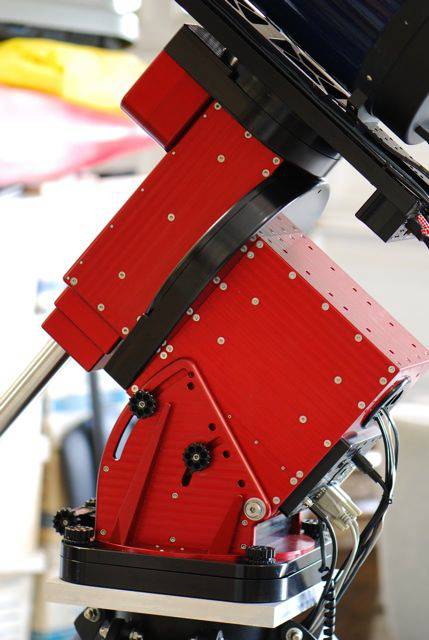

Paramount ME with MKS4000 Control System
The Paramount ME, by Software Bisque, is generally thought to be the best (amateur-class) robotic telescope mount. It was designed specifically for unattended imaging, and includes many unique features that make it very reliable for remote operation. These include homing upon startup - where the mount finds its own position within 1/3 arcsecond, irrespective of power failures or disengaging the worm gear for balancing the mount; through-the-mount cabling - so that there are no dangling wires to get caught and either cause guiding errors or damage the cables; extremely precise pointing - typically 20 arcseconds RMS, using a pointing model such as tPoint; very low inherent periodic (gear) error, and ability to correct it to less than 1 arcsecond peak-to-peak (enabling long exposures while retaining small star images); and robustness - the mount can carry 150 lbs (68 Kg) of equipmnet, not including another 150 lbs of counterweights, all with mechanical pointing accuracy and tracking errors of less than 1 arcsecond! Many people have commented that the Paramount ME is "a work of art". While I do not disagree that the engineering and fabrication is superb, I certainly am more interested in having the mount carry my scopes and imaging packages than displaying it in my living room (which several amateurs have ended-up doing, if they did not have an observatory ready to house their system). In any case, the machining is beautiful, and the mount is extremely functional - making such tasks as polar alignment a real joy. Some additional images of the mount with the Megrez 90 and 12" LX200Rscopes attached are shown below: |
|
The above images show the MKS4000 panel (at left) with through-the-mount wiring (coming out of the circular fitting at the top of the mount), and a side-view of the mount with the altitude lock knobs (at right). This photo also shows a laser pointer mounted to the Paramount base which I used to try to confirm alignment when I rolled the system out onto the driveway (onto marks); unfortunately, the large beam divergence of the diode laser made accurate alignment impossible (I would have needed about 1/4" accuracy over about 40 feet to the neighbor's house, but by that distance, the beam was 2-3" in diameter - roughly 10-20 arcminutes of uncertainty, which is way too much). |
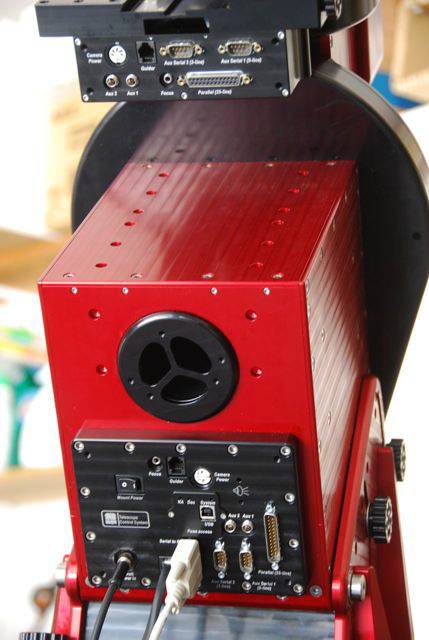 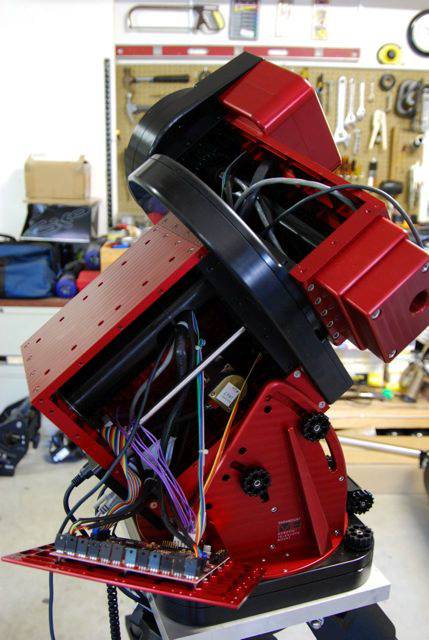 |
The image at left above shows a closer view of the MKS4000 panel. This Paramount was upgraded from the MKS3000 system, but one of the connectors had been plugged-in wrong, so the mount did not work initially; however, it was easy to find the offending connector, and plug it in correctly. The mount has existing cabling for serial connections, guider connection, power for ST-series SBIG cameras, and DC for accessories. The image at right above shows the panels removed in order to feed additional cables through the mount. One must make a turn around the Dec axis in order to leave sufficient play for the mount to operate in all positions without snagging the cables. Unfortunately, it is necessary to remove the Versaplate to add or change cables, necessitating removal of the entire scope (whatever is on the mount) prior to changing cabling. |
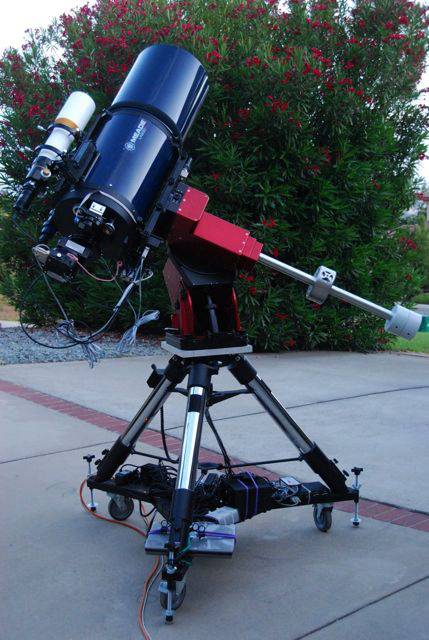 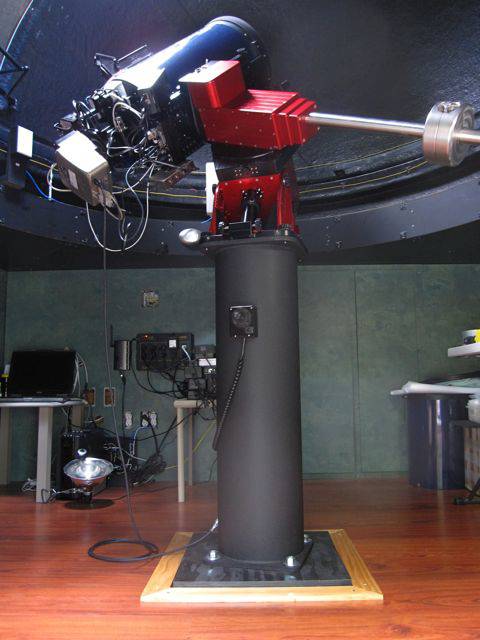 |
The image at left above shows the Paramount ME mounted - via a special adapter plate - to the Meade Giant Field Tripod, which is sitting on JMI wheely bars for rolling the system out to the driveway. I had seen the adapter plate in a photo and advertised on Astromart for something like that; incredibly, the person who actually owned the one from the photo responded, and sold the adapter plate to me - thereby greatly simplifying the mounting of the Paramount ME onto the Meade Giant Field Tripod. I found the GFT very stable - when used on the ground; However, the limiting factor of the system's stability turned out to be the wheely bars, which were not strong enough to handle the nearly 200 lbs (90 Kg) of weight. The thin screw feet of the wheely bars were changed to thick aluminum rod to improve the stability (see: Driveway Mounting) The image at right above shows the Paramount ME mounted on a Software Bisque pier - it mounts without any adapter plates. The pier shown above is 36" in height, after returning the originally-spec'd 24" pier. The 36" pier puts the scope just about at the center of the dome rotation. The single cable you see dangling is the power cable for the STL camera - which I have not yet run through the mount (as this will require disassemblying everything!). The full specifications for the Paramount ME are provided on the Software Bisque web site. A small table of some of the key specifications for the Paramount ME is shown below: |
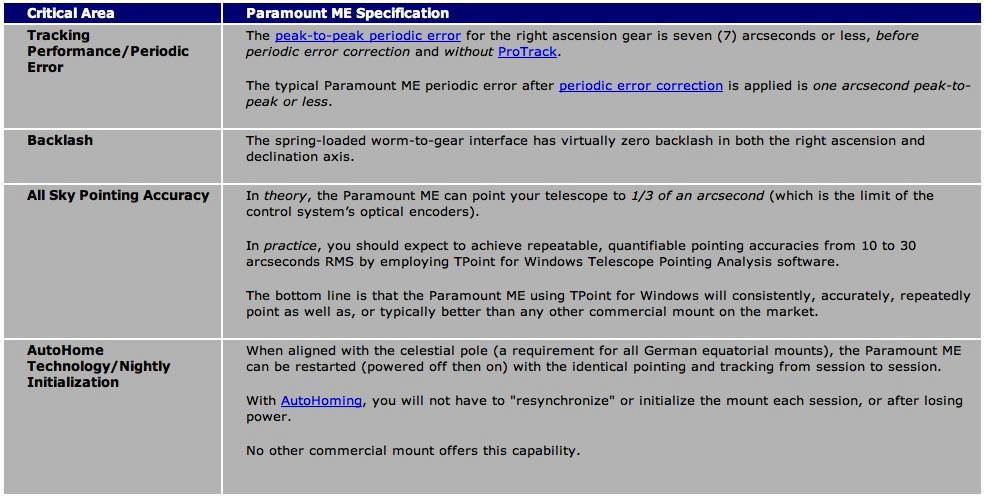 |
My Paramount ME had roughly the maximum spec of periodic error (before correction) of 6-7 arcseconds; after correction using the tPoint model built into TheSky6 Pro (specifically for the Paramount ME), the periodic error was approximately 1 arcsecond peak-to-peak. Without using a corrective system, such as the SBIG adaptive optics (e.g., AO-L) system, a very low periodic error enables keeping star sizes (FWHM) to a minimum, even with relatively long exposure times (such as 20-30 minutes). This allows both unguided exposures, and tracking on non-sidereal objects, such as comets, asteroids, or satellites. The Paramount ME also provides "ProTrack", which uses the pointing model to improve the tracking of the mount (as well as the pointing); this makes possible very accurate unguided imaging - such as following a comet, asteroid, or satellite. I have done some informal teseting of ProTrack - for example, centering on a globular cluster, and making 2-, 5-, or 10-minute unguided exposures with and without ProTrack turned on, and then looking at the FWHM of the resulting stars. While I cannot quote specific figures, it is obvious that ProTrack improves the unguided tracking ability of the mount. The uncorrected periodic error of the ME (with a lot of noise, as it was measured using a short focal length refractor) is shown below. You can see that there is roughly 5-6 arcseconds of error peak-to-peak. |
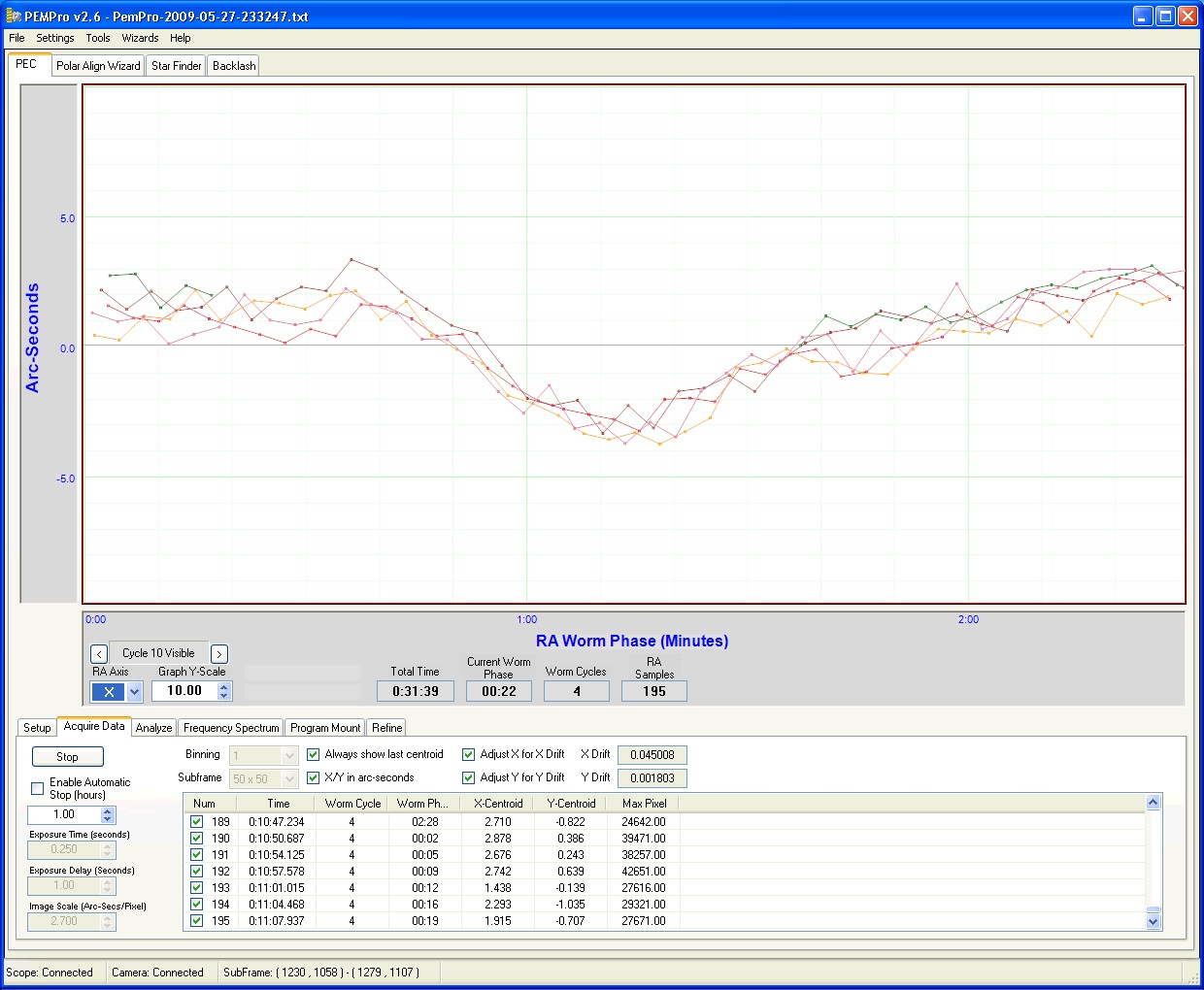 |
The corrected period error of the Paramount ME is shown below; you can see that it is roughly 1-2 arcseconds peak-to-peak. HOWEVER, this data is noisy because I was using a short focal length refractor for these measurements. Subsequent runs using the 12" LX200R (3200 mm focal length) showed under 1 arcsecond total periodic error, which is less than the seeing, so does not contribute to 'bloating' of the stars in the image. |
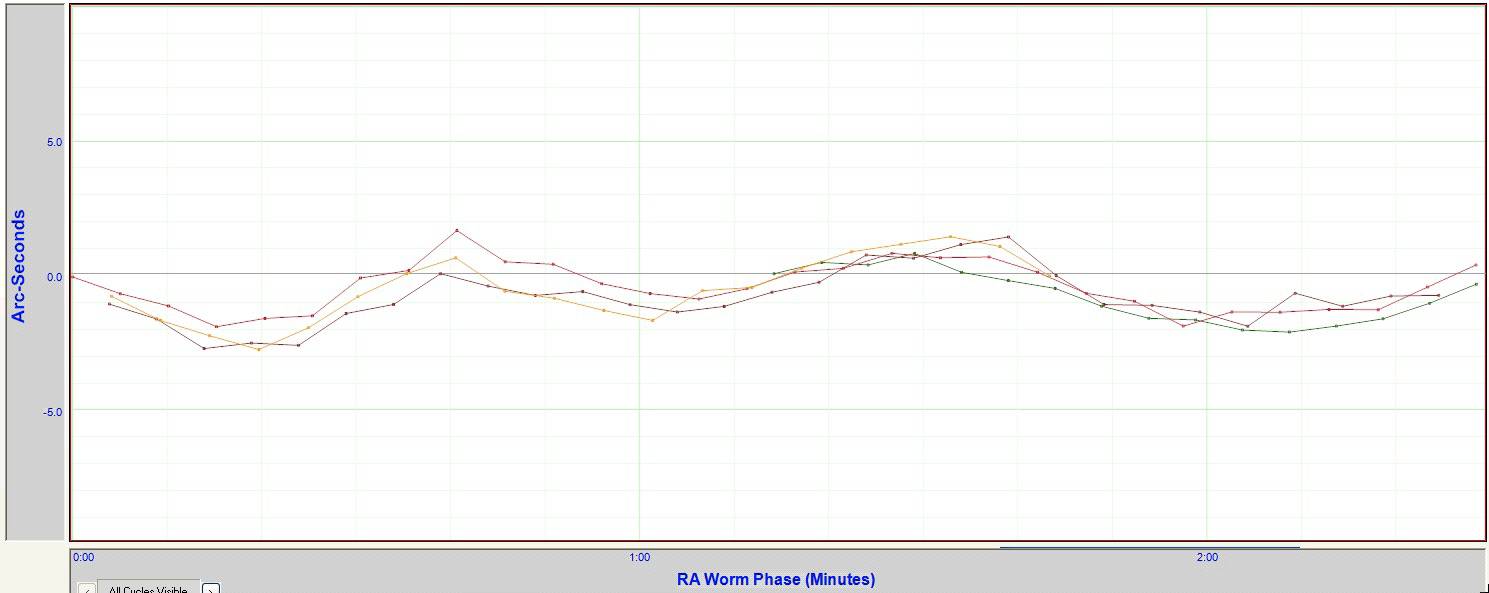 |
Overall, it is a real joy to have a mount that provides precise, stable, and repeatable pointing and tracking, and that carries such a large payload. The Paramount ME is easy to polar align, it is easy to balance, and it is relatively easy to use via TheSky6 Professional. I don't like the proportional handbox that is used while standing at the scope (without a computer); but that is a very minor complaint, offset by incredible advantages using this mount. There are only a handful of other telescope mounts that could be considered at all competitive with the Paramount ME. The Astro Physics 1200 is a great mount, with similar mechanical performance, and better control handbox for use without a computer; but it does not have the remote imaging capabilities of the Paramount. The new Planewave Ascension 200 looks great, but cost about 30% more than the Paramount ME. The Chronos mounts, using a harmonic drive system, able to be aimed anywhere in the sky without a meridian flip, and having great payload-carrying capability, are also more expensive than the Paramount ME. The Takahashi EM500 could be a contender, but weighs about 50% more, has about 30% less payload capacity, and does not have the remote unattended operation capabilities. Therefore, the Paramount ME is quite unique currently among high-end amateur (or low-end professional) telescope mounts. |
As of November 2010, Software Bisque introduced their new Paramount MX - a smaller version of the Paramount ME, with much of the same performance in a smaller form factor, lower load-carrying capability, and lower price. I think the Paramount MX would be the ideal 'portable' field mount for those currently using a Paramount ME - and using "remote imaging" software, even though the scope is in front of your camp. Software Bisque advertises the Paramount MX as "60% of the weight, 60% of the cost". The Parmount MX has a load-carying capacity of 90 lbs, and only weighs 50 lbs. It is expected to sell for about $8,500. |
Paramount ME Software Bisque telescope mount astrophotography unattended remote imaging scope astro-imaging tracking guiding serious amateur platform